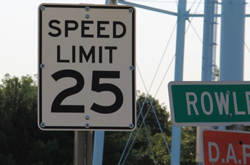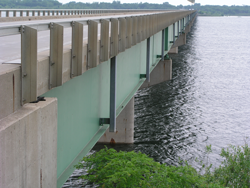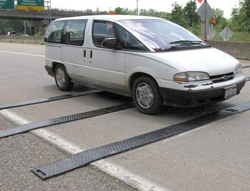Researchers
Konstantina Gkritza
About the research
In 2010, 16.5 percent of all fatal vehicle crashes in Iowa involved large trucks compared to the national average of 7.8 percent. Only about 16 percent of these fatalities involved the occupants of the heavy vehicles, meaning that a majority of the fatalities in fatal crashes involve non-heavy truck occupants. These statistics demonstrate the severe nature of heavy truck crashes and underscore the serious impact that these crashes can have on the traveling public. These statistics also indicate Iowa may have a disproportionately higher safety risk compared to the nation with respect to heavy truck safety.
Several national studies, and a few statewide studies have investigated large truck crashes; however, no rigorous analysis of heavy truck crashes has been conducted for Iowa. The objective of this study was to investigate and identify the causes, locations, and other factors related to heavy truck crashes in Iowa with the goal of reducing crashes and promoting safety. To achieve this objective, this study used the most current statewide data of heavy truck crashes in Iowa.
This study also attempted to assess crash experience with respect to length of commercial driver’s license (CDL) licensure using the most recent five years of CDL data linked to the before mentioned crash data. In addition, this study used inspection and citation data from the Iowa Department of Transportation (DOT) Motor Vehicle Division and Iowa State Patrol to investigate the relationship between enforcement activities and crash experience.
Project Details
07/01/12
06/30/13
Mid-America Transportation Center
U.S. DOT RITA
Researchers
About the research
Assessing the structural integrity of bridge foundations is critical to ensuring the safety of the traveling public. However, nondestructive methods currently used in practice to determine the quality of drilled shaft foundations are severely limited by their inability to provide full coverage of the foundation cross-section, particularly in the critically-important region outside of the rebar cage.
The goal of this project is to evaluate the accuracy of a new thermal integrity profiling (TIP) technique for quality assurance of deep foundations. The TIP method utilizes infrared thermal probes lowered into access pipes, which are cast into the foundation to measure the heat of hydration of curing concrete. Previous studies demonstrated that the technique can detect loss of concrete cover outside the rebar cage, as well as internal flaws such as cracking or voids. However, the studies did not assess the accuracy of the technique for indicating the specific location and extent of flaws.
This research project is a collaborative effort between the Institute for Transportation (InTrans) at Iowa State University and the Iowa Department of Transportation (DOT) to evaluate the accuracy of the TIP method. A full-scale test shaft will be constructed with voids at predetermined locations. Measurements of shaft integrity will be compared for the new TIP method and the cross-hole sonic logging (CSL) method, which is currently the most commonly used quality assurance tool for drilled shafts.
The ability and accuracy of the two techniques to detect the specific locations, size, and general shape of the known shaft defects will then be assessed. It is anticipated that the thermal integrity profiling will provide cost savings to the Iowa DOT as a more economical alternative to CSL testing, or as a screening tool to identify which shafts should be further analyzed by CSL specialists.
Project Details
TR-630, 11-393
01/01/11
10/30/13
Federal Highway Adminisitration Accelerating Safety Activities Program
Iowa Department of Transportation
Iowa Highway Research Board
Midwest Transportation Consortium
U.S. DOT RITA
Researchers
Neal Hawkins
hawkins@iastate.edu email >Director Research Administration, ISU
About the research
The main goal of this research is to provide agencies with tools they can use in designing transition zones from high-speed rural roadways into to low-speed communities.
Funding Sources:
Federal Highway Adminisitration Accelerating Safety Activities Program
Iowa Department of Transportation
Iowa Highway Research Board
Midwest Transportation Consortium
U.S. DOT RITA
Researchers
Travis Hosteng
About the research
The objective of this research is to collect structural performance data (strains, accelerations, etc.) and environmental data (wind speed, direction, etc.) on the Saylorville Reservoir Bridge near Polk City, Iowa for the purpose of developing a self-contained/reporting safety information management system to alert bridge engineers, and more importantly, the public, of high wind events and direct/divert traffic to an alternate route should conditions for bridge passage be unsafe based on the collected data.
Funding Sources:
Iowa Department of Transportation
Midwest Transportation Consortium
U.S. DOT RITA
Researchers
Dawn Marshall
Konstantina Gkritza
About the research
The objective of this project was to determine the effect of headlight configuration (daytime running lights, high beam, modulating) and rider color (bright yellow, blue denim, and black torso and helmet) on the conspicuity of a motorcycle to a driver of a passenger vehicle in a simulated environment. To achieve this, 36 participants completed three drives on a National Advanced Driving Simulator (NADS) 2 driving simulator.
During two of the drives, participants were presented with six oncoming motorcycles and three leading parked motorcycles, each with a different combination of rider color and headlight configuration. Each of the nine motorcycles was present in either the urban or rural driving environment.
Participants indicated when each motorcycle was first visible to them by pressing a button on the steering wheel of the driving simulator. The detection distances from the motorcycles to the participant vehicles were then recorded. Participants were within one of two groups: younger drivers (25 to 55) or older drivers (65 and older).
This research applied repeated measures analysis of variance to investigate the impact of headlight configurations and rider color on motorcycle conspicuity in urban and rural environments. The researchers found that oncoming motorcycles with modulating headlights were detected at the greatest distance compared to motorcycles with high beam or daytime running lights.
Participant ability to detect an oncoming motorcycle was also significantly influenced by the combination of headlight configurations with black or bright yellow rider colors. Leading motorcycles in urban environments were detected at a greater distance compared to those in rural environments. Leading motorcycles with riders having bright yellow clothing and helmet were detected at the greatest distance, followed by motorcycles with riders having blue denim and black rider colors. A significant interaction effect among the driving environment, rider color, and age group was also found for the detection distance of leading motorcycles.
Funding Sources:
Iowa Department of Transportation
Midwest Transportation Consortium
U.S. DOT RITA
Researchers
Kelly Strong
About the research
The objective of this research was to investigate the application of integrated risk modeling to operations and maintenance activities, specifically moving operations, such as pavement testing, pavement marking, painting, snow removal, shoulder work, mowing, and so forth. The ultimate goal is to reduce the frequency and intensity of loss events (property damage, personal injury, and fatality) during operations and maintenance activities.
This report includes a literature review that identifies the current and common practices adopted by different state departments of transportation (DOTs) and other transportation agencies for safe and efficient highway operations and maintenance (O/M) activities. The final appendix to the report includes information for eight innovative O/M risk mitigation technologies/equipmentand covers the following for these technologies/equipment:
- Appropriate conditions for deployment
- Performance/effectiveness, depending on hazard/activity
- Cost to purchase
- Cost to operate and maintain
- Availability (resources and references)
Funding Sources:
Iowa Highway Research Board
Midwest Transportation Consortium
U.S. DOT RITA
Researchers
Tom McDonald
About the research
Red light running (RLR) is a problem in the US that has resulted in 165,000 injuries and 907 fatalities annually. In Iowa, RLR-related crashes make up 24.5 percent of all crashes and account for 31.7 percent of fatal and major injury crashes at signalized intersections.
RLR crashes are a safety concern due to the increased likelihood of injury compared to other types of crashes. One tool used to combat red light running is automated enforcement in the form of RLR cameras. Automated enforcement, while effective, is often controversial.
Cedar Rapids, Iowa installed RLR and speeding cameras at seven intersections across the city. The intersections were chosen based on crash rates and whether cameras could feasibly be placed at the intersection approaches.
The cameras were placed starting in February 2010 with the last one becoming operational in December 2010. An analysis of the effect of the cameras on safety at these intersections was determined prudent in helping to justify the installation and effectiveness of the cameras.
The objective of this research was to assess the safety effectiveness of the RLR program that has been implemented in Cedar Rapids. This was accomplished by analyzing data to determine changes in the following metrics:
- Reductions in red light violation rates based on overall changes, time of day changes, and changes by lane
- Effectiveness of the cameras over time
- Time in which those running the red light enter the intersection
- Changes in the average headway between vehicles entering the intersection
Funding Sources:
Iowa Department of Transportation ($15,000.00)
Midwest Transportation Consortium ($25,000.00)
U.S. DOT RITA
Total: $40,000.00
Project Details
TR-579, 07-311, 08-320
11/01/08
10/30/13
Federal Highway Administration
Iowa Department of Transportation
Iowa Highway Research Board
Midwest Transportation Consortium
Minnesota Department of Transportation
U.S. DOT RITA
Researchers
Neal Hawkins
hawkins@iastate.edu email >Director Research Administration, ISU
Huishan Duan
About the research
The main goal of this research is to evaluate the effectiveness of dynamic speed feedback signs and other low-cost strategies to reduce speeds and crashes on curves. Research results will provide traffic safety and county engineers and other professionals with additional tools to more effectively manage speeds and decrease crashes on horizontal curves on rural roadways.
Funding Sources:
Federal Highway Administration
Iowa Department of Transportation ($80,000.00)
Iowa Highway Research Board
Midwest Transportation Consortium
Minnesota Department of Transportation
U.S. DOT RITA
Total: $80,000.00





